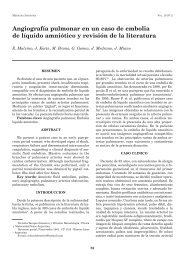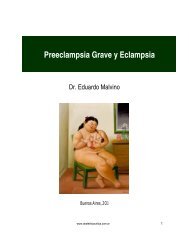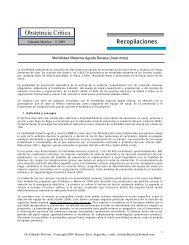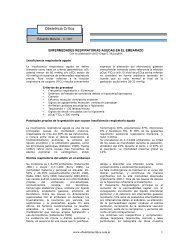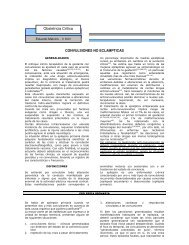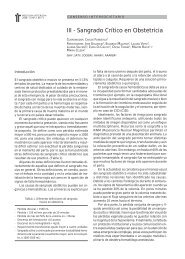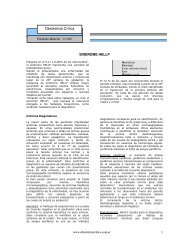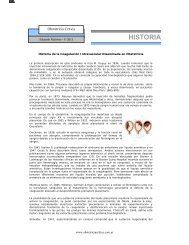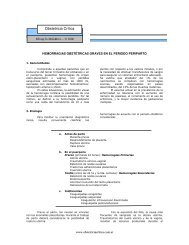J Perinatol. <strong>2008</strong> Feb 21 [Epub ahead of print]Urinalysis vs urine protein-creatinine ratio to predict significant proteinuriain pregnancy.Dwyer BK, Gorman M, Carroll IR, Druzin M.1Division of Maternal Fetal Medicine, Department of Gynecology and Obstetrics,Stanford University, Stanford, CA, USA.Objective: To compare the urine protein-creatinine ratio with urinalysis to predictsignificant proteinuria (>/=300 mg per day).Study Design: A total of 116 pairedspot urine samples and 24-h urine collections were obtained prospectively fromwomen at risk for preeclampsia. Urine protein-creatinine ratio and urinalysis werecompared to the 24-h urine collection.Result: The urine protein-creatinine ratiohad better discriminatory power than urinalysis: the receiver operatingcharacteristic curve had a greater area under the curve, 0.89 (95% confidenceinterval (CI) 0.83 to 0.95) vs 0.71 (95% CI 0.64 to 0.77, P/=0.28) ismore sensitive than urinalysis (cutoff >/=1+): 66 vs 41%, P=0.001 (with 95 and100% specificity, respectively). Furthermore, the urine protein-creatinine ratiopredicted the absence or presence of proteinuria in 64% of patients; urinalysispredicted this in only 19%.Conclusion: The urine protein-creatinine ratio is abetter screening test. It provides early information for more patients.Journal ofPerinatology advance online publication, 21 February <strong>2008</strong>;doi:10.1038/jp.<strong>2008</strong>.4.J Perinatol. <strong>2008</strong> Feb 21 [Epub ahead of print]Patterns of pregnancy exposure to prescription FDA C, D and X drugs in aCanadian population.Wen SW, Yang T, Krewski D, Yang Q, Nimrod C, Garner P, Fraser W,Olatunbosun O, Walker MC.[1] 1OMNI Research Group, Department of Obstetrics and Gynecology,University of Ottawa, Ottawa, ON, Canada [2] 2Clinical Epidemiology Program,Ottawa Health Research Institute, Ottawa, ON, Canada [3] 3Department ofEpidemiology and Community Medicine, University of Ottawa, Ottawa, ON,Canada [4] 4School of Public Health, Central South University, Changsha,Hunan, China [5] 5McLaughlin Centre for Population Health Risk Assessment,Institute of Population Health, University of Ottawa, Ottawa, ON, Canada.Objective:To examine prescription Food and Drug Administration (FDA) C, D andX drugs in general obstetric population.Study Design:Historical cohortstudy.Result:A total of 18 575 women who gave a birth in Saskatchewanbetween January 1997 and December 2000 were included. Among them, 3604(19.4%) received FDA C, D or X drugs at least once during pregnancy. Thepregnancy exposure rates were 15.8, 5.2 and 3.9%, respectively, for category C,D and X drugs, and were 11.2, 7.3 and 8.2%, respectively, in the first, secondand third trimesters. Salbutamol (albuterol), trimethoprim/sulfamethoxazole (cotrimoxazole),ibuprofen, naproxen and oral contraceptives were the mostcommon C, D, X drugs used during pregnancy.Conclusion:About one in every
five women uses FDA C, D and X drugs at least once during pregnancy, and themost common prescription drugs in pregnancy are antiasthmatic, antibiotics,nonsteroid anti-inflammation drugs, antianxiety or antidepressants and oralcontraceptives.Journal of Perinatology advance online publication, 21 February<strong>2008</strong>; doi:10.1038/jp.<strong>2008</strong>.6.Clin Obstet Gynecol. <strong>2008</strong> Mar;51(1):106-18.Principles and practice of teratology for the obstetrician.Fisher B, Rose NC, Carey JC.Department of Obstetrics and Gynecology, University of Utah, Salt Lake City,Utah 84132, USA. barbra.fisher@hsc.utah.eduCommon clinical problems of counseling patients about potential teratogenicrisks in pregnancy are presented and principles of teratogenicity assessment.Clin Obstet Gynecol. <strong>2008</strong> Mar;51(1):84-95.Genetics of pregnancy loss.Warren JE, Silver RM.Departments of Obstetrics and Gynecology, Division of Maternal Fetal Medicine,University of Utah, Salt Lake City, Utah, USA.Pregnancy loss is a common problem in reproductive-aged women. Althoughmost cases of pregnancy loss are sporadic, some couples experience recurrentpregnancy loss, a challenging clinical dilemma. A variety of possible etiologieshave been described for both sporadic and recurrent pregnancy loss. This reviewfocuses on the genetic abnormalities that may contribute to this clinical problemand delineates strategies for genetic evaluation and clinical management insubsequent pregnancies.Clin Obstet Gynecol. <strong>2008</strong> Mar;51(1):74-83.Genetic factors in common obstetric disorders.Ward K.Department of Obstetrics, Gynecology and Women's Health and The PacificResearch Center for Early Human Development, University of Hawai'i, John A.Burns School of Medicine, Honolulu, Hawai'i, USA. ken.ward.hi@mac.comGenetic research of disease has recently turned from individual genes for rarebut highly penetrant diseases (like cystic fibrosis) to focus on common, multigenedisorders with polygenic inheritance patterns, such as preterm labor,preeclampsia, gestational diabetes, placental abruption, and thromboembolism.These conditions are characterized by multiple etiologies, chronicity, fetalinvolvement, adaptive clinical manifestations, and gene-environment interactions.As we understand genetic contributions to complex disease and build upon thegenetic data and technology available, more effective and specific managementand treatment options will become available for clinicians and their patients.Curr Opin Obstet Gynecol. 2007 Dec;19(6):561-7.Postpartum care--what's new?Shaw E, Kaczorowski J.
- Page 1 and 2: Obstetricia CríticaEduardo Malvino
- Page 3 and 4: gestational age at delivery, Apgar
- Page 5 and 6: Maternal risk factors associated wi
- Page 7 and 8: exclusive categories: 1) bleeding r
- Page 9 and 10: Division of Obstetrics and Gynecolo
- Page 11 and 12: as uncommon as primary synovial sar
- Page 13 and 14: Cardiac Troponin I Elevation After
- Page 15 and 16: significant increase in carbohydrat
- Page 17 and 18: of one per 1500 pregnant women. Cal
- Page 19 and 20: Background: To investigate the rela
- Page 21 and 22: PowerLab hardware unit and Chart v3
- Page 23 and 24: Prophylactic antibiotics for the pr
- Page 25: years old (n = 23,921). Univariate
- Page 29 and 30: and complicated. CONCLUSION: Irresp
- Page 31 and 32: clinically effective. Nevertheless,
- Page 33 and 34: Obstetrics and Gynecology Departmen
- Page 35 and 36: Pregnancy-induced severe gestationa
- Page 37 and 38: penicillin or ampicillin, whereas 3
- Page 39 and 40: Abetalipoproteinemia complicating t
- Page 41 and 42: case of acute abdominal pain, abdom
- Page 43 and 44: Callaway LK, Lawlor DA, McIntyre HD
- Page 45 and 46: ketoacidosis during induction of la
- Page 47 and 48: and low platelets (HELLP) syndrome.
- Page 49 and 50: Division of Reproduction and Endocr
- Page 51 and 52: simulation center, and to teamwork
- Page 53 and 54: significantly associated with psori
- Page 55 and 56: episiotomy and prophylactic oxytoci
- Page 57 and 58: ecent obesity epidemic has had a pr
- Page 59 and 60: guidelines in 2002. However, the di
- Page 61 and 62: need for intensive neonatal care, h
- Page 63 and 64: mEq/l) metabolic acidosis. Other et
- Page 65 and 66: Acta Obstet Gynecol Scand. 2008;87(
- Page 67 and 68: etrospective review of pregnancies
- Page 69 and 70: Maternal obesity and pregnancy comp
- Page 71 and 72: interval 3.78-5.30) and severe obst
- Page 73 and 74: of GDM. Methods: 1,662 pregnant wom
- Page 75 and 76: Registers. POPULATION: All pregnant
- Page 77 and 78:
J Reprod Med. 2008 May;53(5):365-8.
- Page 79 and 80:
egarding cervical cancer screening
- Page 81 and 82:
College of Surgeons in Ireland, Dub
- Page 83 and 84:
maternal morbidity has increased bo
- Page 85 and 86:
increased uterine activity was rela
- Page 87 and 88:
options.Journal of Perinatology adv
- Page 89 and 90:
atio, 1.73; 95% CI, 1.11-2.69). Thi
- Page 91 and 92:
discharge at site of perineal repai
- Page 93 and 94:
Thirty-one other patients refused t
- Page 95 and 96:
Department of Obstetrics and Centre
- Page 97 and 98:
developed any new problems. CONCLUS
- Page 99 and 100:
It seems to be safe to continue bre
- Page 101 and 102:
colonization in a subsequent pregna
- Page 103 and 104:
Crude and adjusted odds ratios were
- Page 105 and 106:
the subsequent development of ESRD.
- Page 107 and 108:
Acta Obstet Gynecol Scand. 2008 Sep
- Page 109 and 110:
OBJECTIVE: To investigate pregnancy
- Page 111 and 112:
OBJECTIVE: To compare the perinatal
- Page 113 and 114:
exceptionally rare. CASE: A 23-year
- Page 115 and 116:
CONCLUSION: This case demonstrates
- Page 117 and 118:
peripartum hysterectomy included ce
- Page 119 and 120:
BMJ. 2008 Sep 8;337:a1397. doi: 10.
- Page 121 and 122:
Lancet. 2008 Sep 17. [Epub ahead of
- Page 123 and 124:
Obstet Gynecol. 2008 Oct;112(4):951
- Page 125 and 126:
Additionally, the effects of distur
- Page 127 and 128:
analyzed. Initial echocardiographic
- Page 129 and 130:
pathologic or anatomically anomalou
- Page 131 and 132:
Eur J Obstet Gynecol Reprod Biol. 2
- Page 133 and 134:
chorioamnionitis; and (3) in contra
- Page 135 and 136:
underlying conditions related to st
- Page 137 and 138:
third trimester of pregnancy.BMJ. 2
- Page 139 and 140:
Texas Health Science Center, Housto
- Page 141 and 142:
preterm birth before 34 weeks (P
- Page 143 and 144:
cases. Most patients (91%) received
- Page 145 and 146:
Ultrasound Obstet Gynecol. 2008 Nov
- Page 147 and 148:
Maggard MA, Yermilov I, Li Z, Magli
- Page 149 and 150:
Clinical and Population Health, Per
- Page 151:
the biologic mechanism is unclear,



